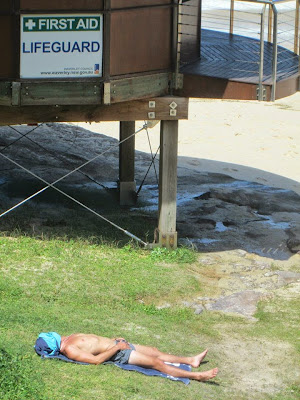On Saturday, March 7, 2015, I spent much of the day roving the eastern beaches of Sydney with my good friend Raph (left). We have a history of roving, Raph and I.
Although Raph lives in the eastern beach-side suburb (or "neighborhood" to my American friends) of Maroubra, we didn't start our roving from there. Instead, we caught a city bus to just south of Clovelly Beach, a small beach at the end of a narrow bay popular with swimmers. The Clovelly Surf Life Saving Club, founded in 1906, is one of the oldest surf lifesaving clubs in the world. Clovelly is surrounded by the suburbs of Bronte to the north, Randwick to the west and Coogee (pictured above) to the south.
Above: A view of the rock platform between Coogee and Clovelly.
Right: Pictured on the sea cliffs between Clovelly and Bronte.
Above: Hopefully this isn't the lifeguard!
Above and below: Waverley Cemetery, located on top of the cliffs at Bronte. As I said to Raph, there's nothing like a crypt with a view!
Established in 1877, Waverley Cemetery is noted for its largely intact Victorian and Edwardian monuments. The cemetery contains the graves of many significant Australians including Henry Lawson, one of Australia's most famous poets; Jules Archibald, founder of The Bulletin and benefactor of the Archibald Prize; nineteenth century poet Henry Kendall; poet and author Dorothea Mackellar; author Ethel Pedley; Olympic swimmer Fanny Durack; and aeronautical pioneer Lawrence Hargrave.
The cemetery is self-funded, deriving its income from interments – including burial, cremation, memorials and mausolea – of which there has been over 86,000. It was designed to function along similar lines to Père Lachaise Cemetery in Paris and Kensal Green Cemetery in London.
Above and below: Some of the beautiful homes around Bronte and Tamarama Beach.
Above: Tamarama Beach, a small beach about one kilometre south of Bondi Beach and a couple of hundred metres north of Bronte Beach. The surrounding area is mostly residential and the beach and adjacent parklands have been popular places for swimming, surfing, sunbaking and picnics for more than a century.
Above and left: Most of the beaches were closed due to the high seas.
Above, left and below: The sea pool at the southern end of Bondi Beach.
"Bondi" or "Boondi" is an Aboriginal word meaning water breaking over rocks or noise of water breaking over rocks. The Australian Museum records that Bondi means place where a flight of nullas took place.
Here's some interesting history of Bondi Beach from Wikipedia:
Bondi Beach was a working class suburb throughout most of the twentieth century with migrant people from New Zealand comprising the majority of the local population. Following World War II, Bondi Beach and the Eastern Suburbs became home for Jewish migrants from Poland, Russia, Hungary, Czechoslovakia and Germany. A stream of Jewish immigration continued into the 21st century and the area has a number of synagogues and a kosher butcher. The area today is very multicultural with a lot of new wealthy Asian families and Samoans. The multicultural migration funded and drove the growth of the suburb throughout the 90's into the turn of the century,[6] moving it steadily from its working class roots towards upper/middle class enclave[7] similar to its neighbors of Rose Bay and Bellevue Hill which was listed as the most expensive postcode in the country in 2003, 2004, 2005.
Above: The south end of Bondi Beach.
Notes Wikipedia:
Bondi Beach is about 1 kilometre (0.62 mi) long and receives many visitors throughout the year. Surf Life Saving Australia has given different hazard ratings to Bondi Beach in 2004. While the northern end has been rated a gentle 4 (with 10 as the most hazardous), the southern side is rated as a 7 due to a famous rip current known as the "Backpackers' Express" because of its proximity to the bus stop, and the unwillingness of tourists to walk the length of the beach to safer swimming. The south end of the beach is generally reserved for surfboard riding. Yellow and red flags define safe swimming areas, and visitors are advised to swim between them.
There is an underwater shark net shared, during the summer months, with other beaches along the southern part of the coast. Pods of whales and dolphins have been sighted in the bay during the months of migration. Fairy penguins, while uncommon, are sometimes also seen swimming close to shore or amongst surfers in southern line-up.
Bondi Beach was added to the Australian National Heritage List in 2008.
Above and below: The open-air gym located toward the north end of Bondi Beach.
Above: Bondi Beach – Saturday, March 7, 2015.
Postscript: The photo above (taken while walking across the Sydney Harbour Bridge) and at left were taken on the evening of March 10, when Raph, his sister Dom and I met up with little Mabel and her dad Victor. Mabel's mum was Raph and Dom's sister Tess, in whose memory Raph cycled over 1900 kilometers last year to raise awareness and funds for melanoma research and prevention.
For more about Raph's inspiring achievement, click here, here, and here.
Left: Raph, me, Dom and Mabel – March 10, 2015.
See also the previous Wild Reed posts:
• Australian Sojourn, March 2015: Part 1 – Brooklyn and Morpeth
• Australian Sojourn, March 2015: Part 2 – Port Macquarie, Wingham, and Ellenborough Falls

.JPG)

.JPG)
























Wonderful summary of our time together! Well written as usual. Peace, Raph
ReplyDelete